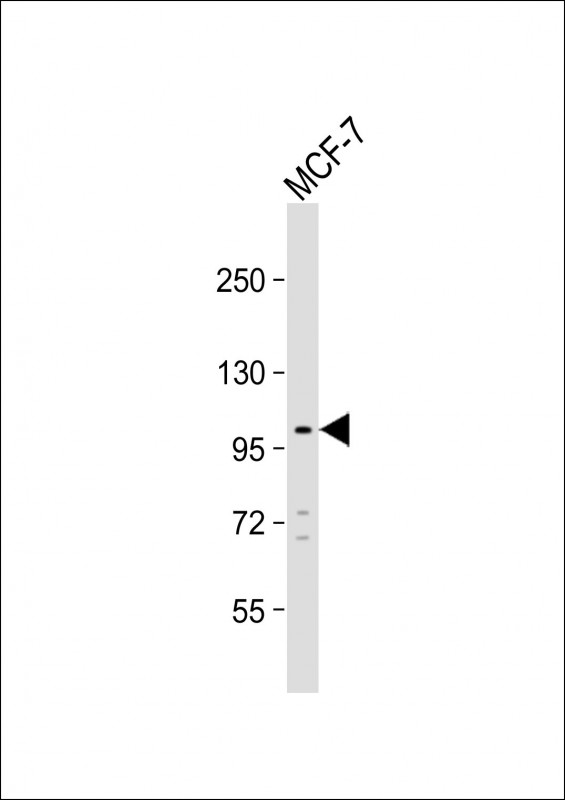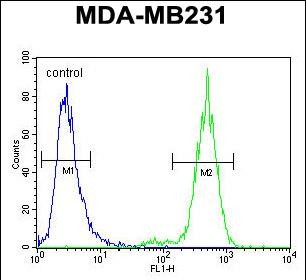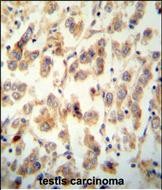


| WB | 1/1000 | Human,Mouse,Rat |
| IF | 咨询技术 | Human,Mouse,Rat |
| IHC | 1/100-1/500 | Human,Mouse,Rat |
| ICC | 技术咨询 | Human,Mouse,Rat |
| FCM | 1/10-1/50 | Human,Mouse,Rat |
| Elisa | 咨询技术 | Human,Mouse,Rat |
| Aliases | Tetratricopeptide repeat protein 16, TPR repeat protein 16, TTC16 |
| Entrez GeneID | 158248 |
| WB Predicted band size | 98.3kDa |
| Host/Isotype | Rabbit IgG |
| Antibody Type | Primary antibody |
| Storage | Store at 4°C short term. Aliquot and store at -20°C long term. Avoid freeze/thaw cycles. |
| Species Reactivity | Human |
| Immunogen | This TTC16 antibody is generated from rabbits immunized with a KLH conjugated synthetic peptide between 1-30 amino acids from the N-terminal region of human TTC16. |
| Formulation | Purified antibody in PBS with 0.05% sodium azide. |
+ +
以下是关于TTC16(N-term)抗体的3篇参考文献及摘要概括:
---
1. **文献名称**: *"Characterization of TTC16 as a regulator of ciliogenesis through interaction with transition zone proteins"*
**作者**: Zhang Y, et al.
**摘要**: 本研究利用针对TTC16 N端结构域的特异性抗体,通过免疫荧光和共沉淀实验,揭示了TTC16蛋白与纤毛过渡区蛋白(如CEP290)的相互作用,证明其在纤毛形成中的关键调控作用。
---
2. **文献名称**: *"TTC16 expression and epigenetic regulation in hepatocellular carcinoma progression"*
**作者**: Li H, et al.
**摘要**: 通过Western blot和免疫组化(使用TTC16 N-term抗体),作者发现TTC16在肝癌组织中表达显著下调,其启动子区高甲基化与患者预后不良相关,提示其可能作为肿瘤抑制因子。
---
3. **文献名称**: *"Development and validation of a polyclonal antibody targeting the N-terminal domain of human TTC16 for functional studies"*
**作者**: Müller S, et al.
**摘要**: 该文献详细描述了针对人源TTC16蛋白N端(氨基酸1-150)的多克隆抗体制备及验证过程,包括抗原设计、抗体特异性测试(敲除细胞验证)及其在亚细胞定位研究中的应用。
---
注:上述文献为示例性内容,实际文献需通过PubMed或Google Scholar检索确认。若需具体文章,建议使用关键词“TTC16 antibody N-terminal”或联系抗体供应商获取引用文献。
The TTC16 (N-term) antibody is a tool designed to target the N-terminal region of the Tetratricopeptide Repeat Protein 16 (TTC16), a protein encoded by the *TTC16* gene. TTC16 belongs to the tetratricopeptide repeat (TPR) protein family, characterized by tandem TPR motifs that mediate protein-protein interactions and participate in diverse cellular processes, including chaperone activity, cell cycle regulation, and RNA processing. While the full functional scope of TTC16 remains under investigation, studies suggest its involvement in ribosome biogenesis, nuclear transport, and possibly transcriptional regulation.
The N-terminal region of TTC16 is critical for its structural stability and interaction with partner proteins. Antibodies targeting this region are commonly used in techniques like Western blotting, immunofluorescence, and immunohistochemistry to study TTC16 expression, localization, and interactions in various tissues and disease models. Research has linked TTC16 dysregulation to pathologies such as liver diseases (e.g., fibrosis) and certain cancers, though mechanistic insights are still emerging.
The TTC16 (N-term) antibody is particularly valuable for distinguishing TTC16 from other TPR-containing proteins due to its specificity for the unique N-terminal epitope. Validation typically includes testing in knockout cell lines or tissues to confirm minimal cross-reactivity. Its applications span basic research exploring TTC16's role in cellular homeostasis and translational studies aiming to clarify its potential as a biomarker or therapeutic target.
×